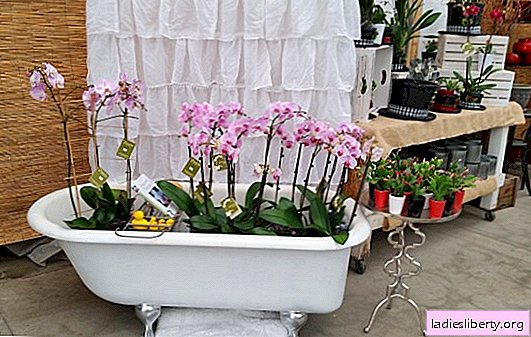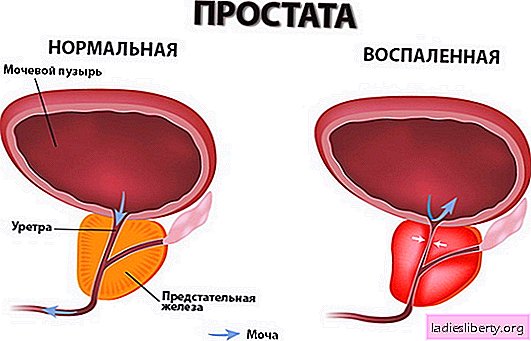
Often, gardeners complain that orchids grow poorly at home, die from root rot. This is because the plant is improperly watered. The watering regime for orchids is special, it depends on the capacity of the flower.
When to water orchids at home: instructions for beginners
The beginning grower needs to remember that the rule applies to this flower - it’s better not to top up than to overfill.
It is necessary to moisten the substrate in the pot when it is completely dry, and the roots change color from bright green to gray-green.
Many people think that watering should be done once a week, but this is not so. For each particular flower, its own mode.
It depends on the ambient temperature, air humidity, lighting and the size of the pot.
For example, in large pots that are in a cool room, the soil is less often moistened.
In a room with central heating, orchids are watered more often, and leaves are additionally sprayed.
Basic watering rules:
1. The substrate is moistened only in the morning.
2. After 30 minutes after irrigation, water is drained from the pan so that the roots do not rot.
3. During watering, drops of water should not fall into the middle of the flower and on the petals.
During budding and flowering, orchids are watered abundantly, but rarely. The roots should dry and ventilate.
What water is better to water orchids at home
The appearance of the flower and the growth rate directly depend on the quality of the water used to moisten the substrate. It is preferable to use soft or medium hardness water, close to natural precipitation.
Hardness of water at home can be determined empirically. If a lot of scale forms in the kettle after boiling, then the water is too hard. It must be mitigated by available means. Oxalic acid is used for flowers.
Instructions for the preparation of water:
1. To 5 liters of water add 0.5 tbsp. l oxalic acid, mix well.
2. Leave the liquid for 24 hours, then carefully drain so that the sediment remains at the bottom.
Orchids are watered with this water. You can add a few drops of lemon juice to it to normalize the level of acidity. Before watering, the water is heated a little so that it is not cold. The optimum water temperature is 35 ° C.
Important! Watering with cold water leads to rapid aging of roots and diseases.
You can soften the tap water with a filter. He also cleans it of fungi and heavy impurities. There is also a folk method - peat peat. It is placed in a tissue bag and lowered into a container of water overnight. This method also increases the acidity of water.
How to water orchids at home if they grow in a transparent pot
The best way to water an adult orchid is a warm shower, it is as close as possible to the natural conditions of growth. After such a manipulation, the plant builds up its green mass well and blooms continuously and abundantly. After a shower, the pots are left for 30 minutes to remove excess moisture. The leaves are wiped with a dry cloth.
Another effective way of watering an orchid is to completely immerse the cache-pot in water. It is valid only for healthy plants. After 30 minutes, remove the pot from the water and allow excess moisture to drain.
You can use surface watering from a watering can. Water is poured carefully so that it does not fall into the growth point. When water leaks through the holes in the pot, watering is stopped. After 5 to 10 minutes, the procedure is repeated.
Important! If the flower grows in an opaque container with drainage holes, then you can determine the time of the next watering using a wooden stick. It is lowered into the substrate and left for 30 minutes. If it stays dry, then it's time to water the orchid.
Features of watering orchid planters without drainage holes
When the orchid grows in a pot without drainage holes, it must be watered as carefully as possible. The soil is rarely moistened so that it is completely dry. To determine the level of humidity will help the above method with a wooden stick.
The substrate is moistened only from a watering can, after watering, the pot is gently knocked over and the excess liquid is drained. The immersion method is not suitable. In rare cases, you can use a warm shower.
Important! As a rule, in a pot without a drainage hole, the orchid is watered every 2 to 3 weeks.
To avoid waterlogging of the roots during watering, a layer of foam or expanded clay should be put on the bottom of the pot when planting. It will absorb excess moisture and gradually give it to the plant.
How to water orchids after transplanting at home
If the orchid transplant was caused by diseases and rot, then immediately after planting in a new substrate, you do not need to moisten the roots. The procedure is done only after 3 to 4 days.
With a planned orchid transplant, the flower must be immediately watered so that the substrate is saturated with moisture. Mineral complexes for orchids can be added to water.
It is best to use the dive method after transplantation. After 30 minutes, remove the pots and let the water drain. Subsequent watering is carried out after 2 to 3 weeks.
How to water orchids in winter
In winter, orchids try not to disturb.
Watering is rare, once every two weeks. Sometimes you can wipe the leaves with a damp cotton pad.
Water for irrigation is used at room temperature, but not cold.
It is best to take the sludge. It is poured into a watering can, and kept for a day in the room where the orchids stand.
For beginning gardeners, an orchid can be difficult to grow.
She needs to provide suitable conditions for keeping and water properly.
If you take into account all the recommendations of experts, then abundant flowering and long flower life is possible even on the windowsill.











